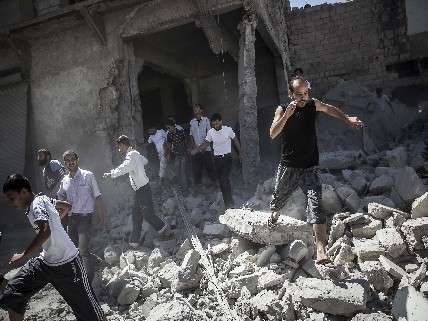Donald Trump Calls For 'Big, Beautiful Safe Zones' in Syria, Wants Gulf States to Pay For Them
"Safe zones" are just "no-fly zones" by another name.


Aleppo — the Syrian city that's been the center of the anti-Assad resistance for more than five years — appears to have finally fallen after a spectacularly brutal onslaught by Syrian government and Russian forces.
President-elect Donald Trump responded to the humanitarian disaster, which includes the indiscriminate bombing of civilians and other atrocities, by telling attendees of a Pennsylvania rally last week, "When I look at what's going on in Syria, it's so sad," adding, "we're going to help people."
Trump said he wants to build "safe zones" for civilians "so they can have a chance." In 2015, Trump also advocated for safe zones as a potential solution to the refugee crisis. Arguing that large numbers of refugees could "destroy all of Europe," Trump instead proposed building "a big beautiful safe zone and you have whatever it is so people can live, and they'll be happier."
Knowing that the creation of such safe zones will require both an enormous financial commitment but also military personnel, Trump called for the oil-rich Sunni Gulf states (presumably including Saudi Arabia, United Arab Emirates, and Qatar), which have been supporting rebel forces, to band their resources together for this vaguely-defined humanitarian project.
During the presidential campaign, Hillary Clinton had called for the imposition of "no-fly zones" in Syria, which Trump warned could "lead to World War 3." Indeed, no-fly zones are enforced with the threat of violence and with Russian fighter jets providing cover for Syria's Assad regime, any U.S. efforts to repel them would reasonably be seen as an act of war. One retired naval officer described no-fly zones as "the cocktail party military application of power of choice," but without an actual proposed end-game, they are potentially disastrous.
That's why Trump's call for "safe zones," while not in the Clinton mold of humanitarian war-making, should also be met with skepticism. Even if Trump is able to convince a regional power like Saudi Arabia to invest its cash and military in providing "safe" areas for civilians, they will inevitably be forced to face down hostile actors — be they Assad's military forces, Russian forces, or even ISIS. It's hard to imagine the Saudis sticking their necks out for Syrian civilians, especially after more than half a decade of civil war in Syria.
Besides, even if the Saudis did intervene at this late stage, they're bogged down with their own war in Yemen, where they've very likely committed war crimes against that country's civilian population backed by both U.S.-provided weapons and even U.S. tactical military support.
Trump's foreign policy — nearly always inscrutable during the campaign — is slowly being fleshed out. His opposition to military intervention in Syria won him plaudits from some anti-war libertarians, but "safe zones" are just "no-fly zones" by another name. And even if Trump is able to convince the U.S.' nominal allies in the Gulf to intervene on behalf of civilians, he should remember that they'll inevitably lean on the U.S. for support, and that's the kind of mission creep that inevitably drags a country into a war.


Show Comments (256)